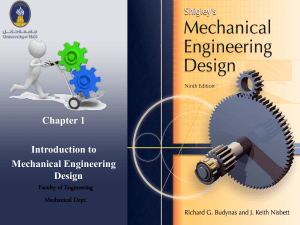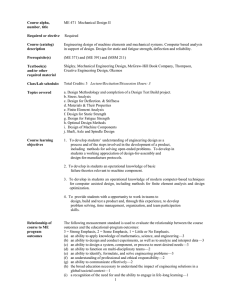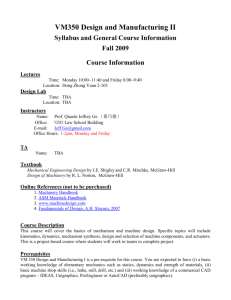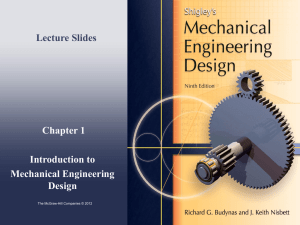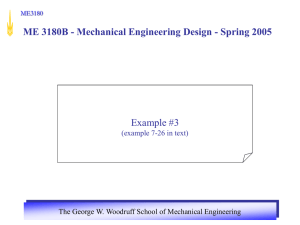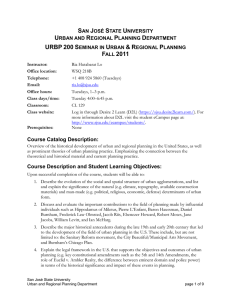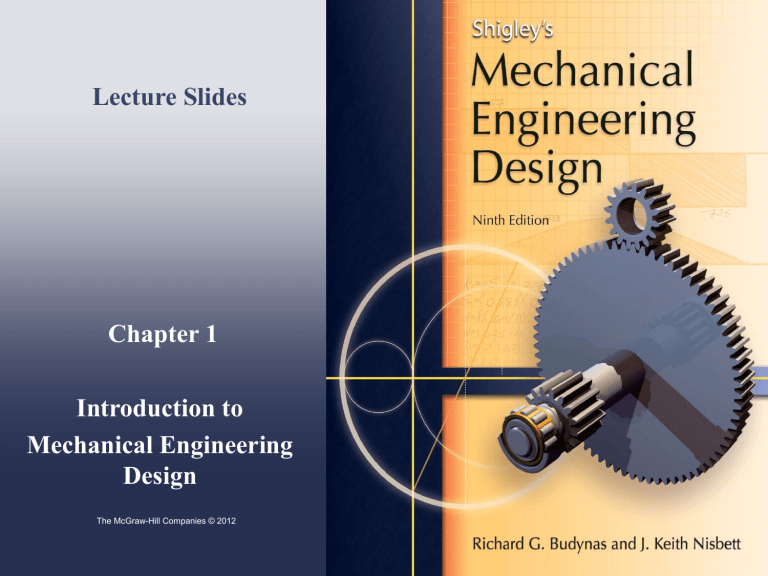
Lecture Slides Chapter 1 Introduction to Mechanical Engineering Design The McGraw-Hill Companies © 2012 Chapter Outline Shigley’s Mechanical Engineering Design Design To formulate a plan for the satisfaction of a specified need Process requires innovation, iteration, and decision-making Communication-intensive Products should be ◦ Functional ◦ Safe ◦ Reliable ◦ Competitive ◦ Usable ◦ Manufacturable ◦ Marketable Shigley’s Mechanical Engineering Design Mechanical Engineering Design Mechanical engineering design involves all the disciplines of mechanical engineering. Example ◦ Journal bearing: fluid flow, heat transfer, friction, energy transport, material selection, thermomechanical treatments, statistical descriptions, etc. Shigley’s Mechanical Engineering Design The Design Process Iterative in nature Requires initial estimation, followed by continued refinement Shigley’s Mechanical Engineering Design Design Considerations Some characteristics that influence the design Shigley’s Mechanical Engineering Design Computational Tools Computer-Aided Engineering (CAE) ◦ Any use of the computer and software to aid in the engineering process ◦ Includes Computer-Aided Design (CAD) Drafting, 3-D solid modeling, etc. Computer-Aided Manufacturing (CAM) CNC toolpath, rapid prototyping, etc. Engineering analysis and simulation Finite element, fluid flow, dynamic analysis, motion, etc. Math solvers Spreadsheet, procedural programming language, equation solver, etc. Shigley’s Mechanical Engineering Design Acquiring Technical Information Libraries ◦ Engineering handbooks, textbooks, journals, patents, etc. Government sources ◦ Government agencies, U.S. Patent and Trademark, National Institute for Standards and Technology, etc. Professional Societies (conferences, publications, etc.) ◦ American Society of Mechanical Engineers, Society of Manufacturing Engineers, Society of Automotive Engineers, etc. Commercial vendors ◦ Catalogs, technical literature, test data, etc. Internet Access to much of the above information Shigley’s Mechanical Engineering Design A Few Useful Internet Sites www.globalspec.com www.engnetglobal.com www.efunda.com www.thomasnet.com www.uspto.gov Shigley’s Mechanical Engineering Design The Design Engineer’s Professional Responsibilities Satisfy the needs of the customer in a competent, responsible, ethical, and professional manner. Some key advise for a professional engineer ◦ Be competent ◦ Keep current in field of practice ◦ Keep good documentation ◦ Ensure good and timely communication ◦ Act professionally and ethically Shigley’s Mechanical Engineering Design Ethical Guidelines for Professional Practice National Society of Professional Engineers (NSPE) publishes a Code of Ethics for Engineers and an Engineers’ Creed. www.nspe.org/ethics Six Fundamental Canons Engineers, in the fulfillment of their professional duties, shall: ◦ Hold paramount the safety, health, and welfare of the public. ◦ Perform services only in areas of their competence. ◦ Issue public statements only in an objective and truthful manner. ◦ Act for each employer or client as faithful agents or trustees. ◦ Avoid deceptive acts. ◦ Conduct themselves honorably, responsibly, ethically, and lawfully so as to enhance the honor, reputation, and usefulness of the profession. Shigley’s Mechanical Engineering Design NSPE Engineers’ Creed As a Professional Engineer I dedicate my professional knowledge and skill to the advancement and betterment of human welfare. I pledge: ◦ To give the utmost of performance; ◦ To participate in none but honest enterprise; ◦ To live and work according to the laws of man and the highest standards of professional conduct; ◦ To place service before profit, the honor and standing of the profession before personal advantage, and the public welfare above all other considerations. In humility and with need for Divine Guidance, I make this pledge. Shigley’s Mechanical Engineering Design Standards and Codes Standard ◦ A set of specifications for parts, materials, or processes ◦ Intended to achieve uniformity, efficiency, and a specified quality ◦ Limits the multitude of variations Code ◦ A set of specifications for the analysis, design, manufacture, and construction of something ◦ To achieve a specified degree of safety, efficiency, and performance or quality ◦ Does not imply absolute safety Various organizations establish and publish standards and codes for common and/or critical industries Shigley’s Mechanical Engineering Design Standards and Codes Some organizations that establish standards and codes of particular interest to mechanical engineers: Shigley’s Mechanical Engineering Design Economics Cost is almost always an important factor in engineering design. Use of standard sizes is a first principle of cost reduction. Table A-17 lists some typical preferred sizes. Certain common components may be less expensive in stocked sizes. Shigley’s Mechanical Engineering Design Tolerances Close tolerances generally increase cost ◦ Require additional processing steps ◦ Require additional inspection ◦ Require machines with lower production rates Shigley’s Mechanical Engineering Design Breakeven Points A cost comparison between two possible production methods Often there is a breakeven point on quantity of production EXAMPLE Automatic screw machine 25 parts/hr 3 hr setup $20/hr labor cost Hand screw machine 10 parts/hr Minimal setup $20/hr labor cost Breakeven at 50 units Shigley’s Mechanical Engineering Design Safety and Product Liability Strict Liability concept generally prevails in U.S. Manufacturer is liable for damage or harm that results because of a defect. Negligence need not be proved. Calls for good engineering in analysis and design, quality control, and comprehensive testing. Shigley’s Mechanical Engineering Design Stress and Strength Strength ◦ An inherent property of a material or of a mechanical element ◦ Depends on treatment and processing ◦ May or may not be uniform throughout the part ◦ Examples: Ultimate strength, yield strength Stress ◦ A state property at a specific point within a body ◦ Primarily a function of load and geometry ◦ Sometimes also a function of temperature and processing Shigley’s Mechanical Engineering Design Uncertainty Common sources of uncertainty in stress or strength Shigley’s Mechanical Engineering Design Uncertainty Stochastic method ◦ Based on statistical nature of the design parameters ◦ Focus on the probability of survival of the design’s function (reliability) ◦ Often limited by availability of statistical data Shigley’s Mechanical Engineering Design Uncertainty Deterministic method ◦ Establishes a design factor, nd ◦ Based on absolute uncertainties of a loss-of-function parameter and a maximum allowable parameter ◦ If, for example, the parameter is load, then Shigley’s Mechanical Engineering Design Example 1-1 Solution Answer Answer Shigley’s Mechanical Engineering Design Design Factor Method Often used when statistical data is not available Since stress may not vary linearly with load, it is more common to express the design factor in terms of strength and stress. All loss-of-function modes must be analyzed, and the mode with the smallest design factor governs. Stress and strength terms must be of the same type and units. Stress and strength must apply to the same critical location in the part. The factor of safety is the realized design factor of the final design, including rounding up to standard size or available components. Shigley’s Mechanical Engineering Design Example 1-2 Solution Answer Answer Shigley’s Mechanical Engineering Design Reliability Reliability, R – The statistical measure of the probability that a mechanical element will not fail in use Probability of Failure, pf – the number of instances of failures per total number of possible instances Example: If 1000 parts are manufactured, with 6 of the parts failing, the reliability is or 99.4 % Shigley’s Mechanical Engineering Design Reliability Series System – a system that is deemed to have failed if any component within the system fails The overall reliability of a series system is the product of the reliabilities of the individual components. n R Ri (1-5) i 1 Example: A shaft with two bearings having reliabilities of 95% and 98% has an overall reliability of R = R1 R2 = 0.95 (0.98) = 0.93 or 93% Shigley’s Mechanical Engineering Design Dimensions and Tolerances Nominal size – The size we use in speaking of an element. ◦ Is not required to match the actual dimension Limits – The stated maximum and minimum dimensions Tolerance – The difference between the two limits Bilateral tolerance – The variation in both directions from the basic dimension, e.g. 1.005 ± 0.002 in. Unilateral tolerance – The basic dimension is taken as one of the limits, and variation is permitted in only one direction, e.g. Shigley’s Mechanical Engineering Design Dimensions and Tolerances Clearance – Refers to the difference in sizes of two mating cylindrical parts such as a bolt and a hole. ◦ Assumes the internal member is smaller than the external member ◦ Diametral clearance – difference in the two diameters ◦ Radial clearance – difference in the two radii Interference – The opposite of clearance, when the internal member is larger than the external member Allowance – The minimum stated clearance or the maximum stated interference or mating parts Shigley’s Mechanical Engineering Design Example 1-3 Figure 1-4 Shigley’s Mechanical Engineering Design Example 1-3 (Continued) Solution Answer Answer Answer Shigley’s Mechanical Engineering Design Linked End-Of-Chapter Problems Shigley’s Mechanical Engineering Design Power Transmission Case Study Specifications Shigley’s Mechanical Engineering Design Power Transmission Case Study Specifications Shigley’s Mechanical Engineering Design Power Transmission Case Study Specifications Shigley’s Mechanical Engineering Design
